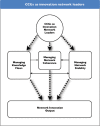Leadership of healthcare commissioning networks in England: a mixed-methods study on clinical commissioning groups
- PMID: 23430596
- PMCID: PMC3586053
- DOI: 10.1136/bmjopen-2012-002112
Leadership of healthcare commissioning networks in England: a mixed-methods study on clinical commissioning groups
Abstract
Objective: To explore the relational challenges for general practitioner (GP) leaders setting up new network-centric commissioning organisations in the recent health policy reform in England, we use innovation network theory to identify key network leadership practices that facilitate healthcare innovation.
Design: Mixed-method, multisite and case study research.
Setting: Six clinical commissioning groups and local clusters in the East of England area, covering in total 208 GPs and 1 662 000 population.
Methods: Semistructured interviews with 56 lead GPs, practice managers and staff from the local health authorities (primary care trusts, PCT) as well as various healthcare professionals; 21 observations of clinical commissioning group (CCG) board and executive meetings; electronic survey of 58 CCG board members (these included GPs, practice managers, PCT employees, nurses and patient representatives) and subsequent social network analysis.
Main outcome measures: Collaborative relationships between CCG board members and stakeholders from their healthcare network; clarifying the role of GPs as network leaders; strengths and areas for development of CCGs.
Results: Drawing upon innovation network theory provides unique insights of the CCG leaders' activities in establishing best practices and introducing new clinical pathways. In this context we identified three network leadership roles: managing knowledge flows, managing network coherence and managing network stability. Knowledge sharing and effective collaboration among GPs enable network stability and the alignment of CCG objectives with those of the wider health system (network coherence). Even though activities varied between commissioning groups, collaborative initiatives were common. However, there was significant variation among CCGs around the level of engagement with providers, patients and local authorities. Locality (sub) groups played an important role because they linked commissioning decisions with patient needs and brought the leaders closer to frontline stakeholders.
Conclusions: With the new commissioning arrangements, the leaders should seek to move away from dyadic and transactional relationships to a network structure, thereby emphasising on the emerging relational focus of their roles. Managing knowledge mobility, healthcare network coherence and network stability are the three clinical leadership processes that CCG leaders need to consider in coordinating their network and facilitating the development of good clinical commissioning decisions, best practices and innovative services. To successfully manage these processes, CCG leaders need to leverage the relational capabilities of their network as well as their clinical expertise to establish appropriate collaborations that may improve the healthcare services in England. Lack of local GP engagement adds uncertainty to the system and increases the risk of commissioning decisions being irrelevant and inefficient from patient and provider perspectives.
Figures





Similar articles
-
The capacity of health service commissioners to use evidence: a case study.Southampton (UK): NIHR Journals Library; 2018 Mar. Southampton (UK): NIHR Journals Library; 2018 Mar. PMID: 29553690 Free Books & Documents. Review.
-
General practitioners' views of clinically led commissioning: cross-sectional survey in England.BMJ Open. 2017 Jun 8;7(6):e015464. doi: 10.1136/bmjopen-2016-015464. BMJ Open. 2017. PMID: 28596217 Free PMC article.
-
How are clinical commissioning groups managing conflicts of interest under primary care co-commissioning in England? A qualitative analysis.BMJ Open. 2017 Nov 8;7(11):e018422. doi: 10.1136/bmjopen-2017-018422. BMJ Open. 2017. PMID: 29122801 Free PMC article.
-
GP leadership in clinical commissioning groups: a qualitative multi-case study approach across England.Br J Gen Pract. 2018 Jun;68(671):e427-e432. doi: 10.3399/bjgp18X696197. Epub 2018 May 8. Br J Gen Pract. 2018. PMID: 29739777 Free PMC article.
-
Clinical leadership in service redesign using Clinical Commissioning Groups: a mixed-methods study.Southampton (UK): NIHR Journals Library; 2018 Jan. Southampton (UK): NIHR Journals Library; 2018 Jan. PMID: 29356472 Free Books & Documents. Review.
Cited by
-
Making the case for a fracture liaison service: a qualitative study of the experiences of clinicians and service managers.BMC Musculoskelet Disord. 2015 Oct 1;16:274. doi: 10.1186/s12891-015-0722-z. BMC Musculoskelet Disord. 2015. PMID: 26429346 Free PMC article.
-
Family physicians collaborating for health system integration: a scoping review.BMC Health Serv Res. 2023 Jan 23;23(1):68. doi: 10.1186/s12913-023-09063-w. BMC Health Serv Res. 2023. PMID: 36690992 Free PMC article.
-
Features that hindered the capacity development of a national prostate cancer service.Front Health Serv. 2023 Jul 18;3:1173143. doi: 10.3389/frhs.2023.1173143. eCollection 2023. Front Health Serv. 2023. PMID: 37533703 Free PMC article.
-
The psychosocial response to a terrorist attack at Manchester Arena, 2017: a process evaluation.BMC Psychol. 2021 Feb 2;9(1):22. doi: 10.1186/s40359-021-00527-4. BMC Psychol. 2021. PMID: 33531071 Free PMC article.
-
Is postgraduate leadership education a match for the wicked problems of health systems leadership? A critical systematic review.Perspect Med Educ. 2019 Jun;8(3):133-142. doi: 10.1007/s40037-019-0517-2. Perspect Med Educ. 2019. PMID: 31161480 Free PMC article.
References
-
- Department of Health Equity and excellence: liberating the NHS,London, 2010
-
- Department of Health Practice based commissioning: technical guidance, London, 2005
-
- Williams D. Under Doctors’ orders. Public Finance 2010;August
-
- Woodin J, Wade E. Towards World Class Commissioning Competency, Services Management Centre, University of Birmingham, Birmingham, 2007
-
- Goodwin N. Are networks the answer to achieving integrated care? J Health Serv Res Policy 2008;13:58–60 - PubMed
LinkOut - more resources
Full Text Sources
Other Literature Sources
